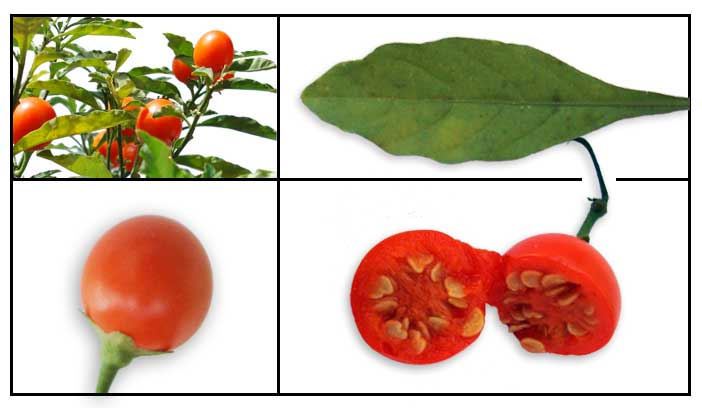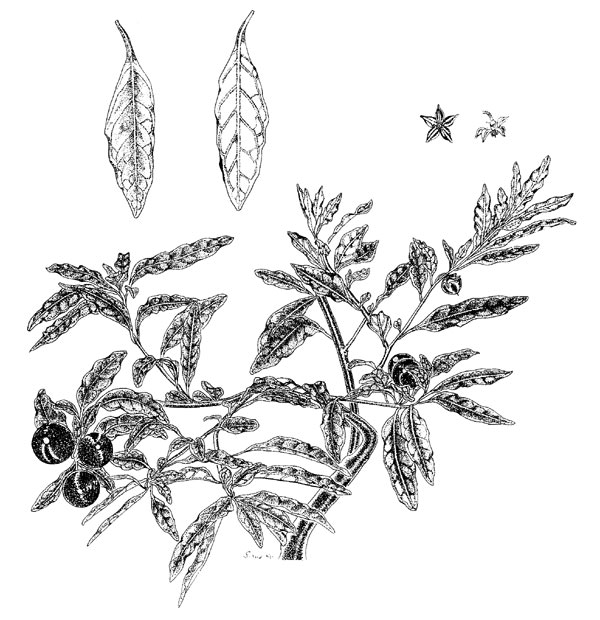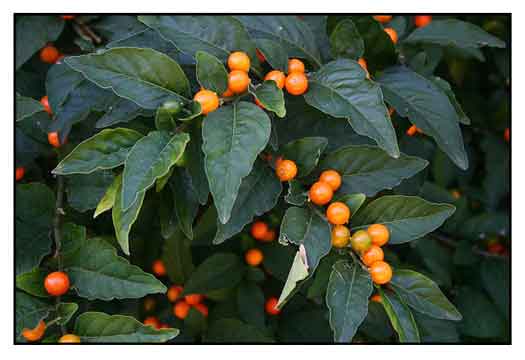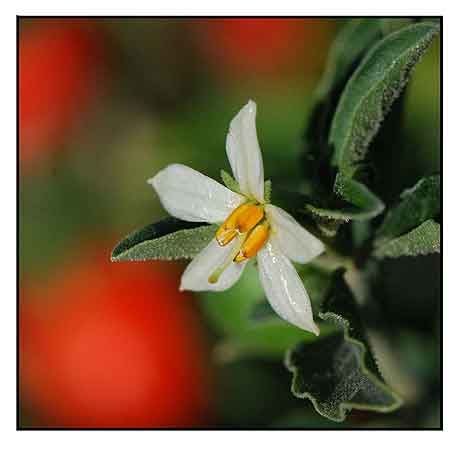|

Gen info
- Solanum pseudocapsicum is a nightshade species, with mildly poisonous fruit. Jerusalem cherry is a member of the Solanaceae or nightshade family which also includes tomatoes, potatoes, peppers, and eggplants.
- They are congeners of tomatoes and the fruit is extremely similar to cherry tomatoes in taste and texture, and easily confused with them.
-
Etymology: The genus name 'Solanum' derives from Latin 'solamen', meaning comforting or soothing.
- If ingested, Jerusalem cherry is toxic to children, dogs, cats, and horses.
(see toxicity below) (24)
Botany
Jerusalem cherry is a small to medium-sized, erect, bushy, perennial evergreen, branched and non-spiny shrub
growing to a height of one meter. Stems are green and wiry. Leaves are alternate, oblong to lanceolate, glossy green above, elliptical to lanceolate in shape, with wavy margins, 2-8 cm long, 1.5-2 cm wide, hairless or covered with short hairs. Flowers are nodal, white
or light purple, solitary or occasionally in clusters. Fruit is globose, yellow or orange red, 1.2-1.5 cm in diameter. Seeds are disk-like 2-3 mm wide.
 Distribution Distribution
- Introduced. (10)
-
Ornamental cultivation in Philippines.
- Common in commercial botanical gardens in Baguio.
- Native to South America: Argentina, Bolivia, Brazil, Chile, Juan Fernandez Is., Paraguay, Uruguay.
(10)
Constituents
- GC-MS study of root for volatile components yielded 41 compounds, representing 50% of the oil. Major components were fatty acids (26.8%), terpenoids (7.6%), and aldehydes (5.3%). Dominant compounds were hexadecanoic acid (24.1%), 2-methoxy-3-isopropylpyrazine (2.8%), and 15-methylhexadecanoic acid (2.1%). Other notable components were ß-elemene and δ-elemene. (6)
- Phytochemical studies have yielded alkaloids, glycosides, tannins and
flavonoids.
- Berries contain substantial amounts of phosphorus and nitrogen.
- Analysis of berries yielded 25 components, constituting 99.8% of extract composition. The major components were alkaloids (38.55%), hydrocarbons (22.18%), fatty acid (19.38%), alcohol (13.27%), and carboxylic derivatives (3.73%). Mineral nutrient analysis yielded substantial amounts of phosphorus and nitrogen. (11)
- Study of essential oil of unripe berries yielded twenty-one compounds, constituting 69.24% of total oil components. Major compounds were homologous series of alkanes, alcohol, aldehyde and terpenoids. The dominant components were decane (41.06%), undecane (29.26%), monoterpenoids (14.79%), sesquiterpene (3.21%) and a diterpene phytol (5.94%). (12)
- Alkaloids identified in S. pseudocapsicum are solanocapsine; solacasine; solateinemine; 2-fluoro-2',4,5 benzenethanamine; hexatriacontane; 3-ethoxyamphetamine; 2,2,2-trichloroacetamide; O-methylsolanocapsine; episolacapine; and isosolacapine. (16)
- GCMS analysis of hexane extractable fraction of leaves of S. pseudocapsicum yielded 35 compounds, of which 26 were identified accounting for 40-81% of the composition. Fraction 1 (F1) was dominated by alkanes (74.8%) with decane (44.1%), undecane (24.6%) and nonane (6.1%) as main constituents.
F2 was dominated by alkanes, decane, undecane, tetradecane, and hexadecane. F3 showed a high proportion of nonane, terpenes, ketones, and an alcohol. F4 showed a high proportion of terpenes. dominated by acyclic diterpene phytol (35.8%). The presence of diterpene phytol in fraction 4 was reported to be toxic and lethal and reported to activate the peroxisome proliferator=activated receptor α (PPARα) and regulates gene expression involved in lipid metabolism in PPARα-expressing HepG2 hepatocytes. (19)
Properties
- All parts of the plant are considered poisonous, especially unripe fruits.
- Studies have suggest anticancer, biopesticidal, antitumor, antioxidant, hepatoprotective, cytotoxic, antibacterial properties.
 Caution / Toxicity concerns Caution / Toxicity concerns
- Poison / Solanocapsine: Considered a poisonous plant. The poisonous ingredient was reported as primarily solanocapsine, found throughout the Jerusalem cherry plant, but especially in the unripened fruit and leaves. Symptoms of poisoning include altered mental status, coma, delirium, diarrhea, drowsiness, dilated pupils, hallucinations, headache, low blood pressure, slow breathing, slow pulse, salivation, stomach pains, and vomiting. (13)
- Studies have implicated the berries in causing central
anticholinergic syndrome characterized by thought impairment, recent
memory disturbance, hallucinations, hyperpyrexia, ataxia, drowsiness,
tachycardia, coma among others. Extract studies were predominated by
alkaloids (38.55%). Other plant components detected were aramines, phentamins,
dopamine, fluoxotine and amphetamine derivatives – potent psychostimulant
in humans. Many of the compounds have pharmacological and toxicological
importance in humans and the berries present of source of raw materials
for drug development. (Research
Paper)
- Historically, induced emesis was recommended for Solanum ingestion, especially in children, but that does not coincide with current decontamination recommendations. Prolonged observation may be necessary for children in context of high likelihood of ingestion. Management includes intravenous fluids, antiemetics for nausea, vomiting, and dehydration. Physostigine is a consideration for obvious anticholinergic presentation. A case report of rare anticholinergic effects was attributed to dulcamarine, an atropine-liked compound. The anticholinergic syndrome was successfully treated with physostigmine. (21)
 Parts
used Parts
used
Bark, fruit, leaves and
seeds.
Uses
Folkloric
- No reported medicinal use in the Philippines.
- In India, used in homeopathy
medicine to treat acute lower abdominal pain and somnolence.
- In South Africa, reported topical use for treatment of boils and gonorrhea; orally, as a male tonic and
for abdominal pain.
- In the Newar community of Pharping village in Kathmandu, Nepal, reported use of raw fruit for diabetes. (17)
Studies
• Cytotoxicity / O-methylsolanocapsine / Leaves: Study evaluated the in vitro cytotoxic properties of O-methylsolanocapsine
isolated from Solanum pseudocapsicum leaves. Several steroidal alkaloids including solanocapsine, solacasine, solacapine, episolacapine, isosolacapine, and O-methylsolanocapsine were isolated from the arboreal part of the plants. Study confirmed O-methylsolanocapsine is more cytotoxic to the HeLa cell lines. Results indicate the steroidal alkaloids possess strong cytotoxic and antitumor properties. (1)
• Antioxidant / Leaves: Study evaluated various extracts of S. pseudocapsicum leaves for in vitro antioxidant activity. A crude methanolic extract showed potent antioxidant activity with IC50s of 49.57 ± 0.15 and 79.00 ± 0.08 mg/ml on DPPH and nitric oxide assays, respectively. The extracts exhibited no activity in the scavenging of hydroxyl or superoxide
radicals. Also, none of the extracts were more active than standards (ascorbic acid and rutin). (2)
• Antitumor / Leaves: Antitumor activity
of total alkaloid fraction of solanum pseudocapsicum leaves was tested
against Dalton's Lymphoma Ascites model in mice and revealed increase
in mean survival time and life span of tumor-bearing mice. The observed
activity may be due to its cytotoxic properties. (4)
• Anti-cancer: Study on leaf
extracts has isolated 0-methylsolanocapsine with in vitro cytotoxic
properties against some cancerous cell lines and merits in vivo studies
to confirm its antitumor activity.
• Solacasine / Antibacterial:
Systematic fractionation of alcohol extracts showed solacasine,
a new steroidal alkaloid, to be the main antibacterial constituent. (3)
• Hepatoprotective: Alkaloid
fraction of the methanol extract of Solanum pseudocapsicum was tested
for hepatoprotective activity against CCl4 induced toxicity in rat hepatocytes
and showed antihepatotoxic effect at very low concentrations and suggests
further studies of the alkaloid fraction to identify the active principles. (5)
• Volatile Compounds / Roots: Hydrodistillation
yielded 41 compounds (50% of the oil) from the roots of Solanum pseudocapsicum.
The dominant compounds were hexadecanoic acid (24.1%), 2-methoxy-3-isopropylpyrazine
(2.8%) and 15-methylhexadecanoic acid (2.1%). The high proportion of
the fatty acids was considered to be contributory to its medicinal properties. (6)
• Antioxidant: Of
the six extracts of SP tested for antioxidant activity, the crude methanolic
extract showed potent antioxidant activity. The extract also showed
potent scavenging activity against ABTS free radical, however, in a
degree less than the standards used. (7)
• Cytotoxic Activity of Alkaloids / Leaves, Ripe Fruits, Roots, Seeds, Stems: All five alkaloid fractions
of the methanolic extracts of leaves, ripe fruits, roots, seeds and
stems of SP showed potent cytotoxic activity with the HT-29 cell line
showing the most sensitivity. The most potent was found in the total alkaloid fraction
of leaves. In short-term toxicity studies, fractions showed 50% viability at 93-128 µg/ml for DLA cells and 141-189 µg/ml for human lymphocytes. (8)
• Chemical and Nutrient Analysis of Berries: Analysis of berries yielded 25 components, constituting 99.8% of extract composition. Major components were dominated by alkaloids (38.55%), hydrocarbons (22.18%), fatty acids (19.38%), alcohols (13.27%) and the derivatives of carboxylic acid (3.73%). Mineral nutrient evaluation showed substantial amount of phosphorus and nitrogen. The presence of other components such as aramines, phentamines, dopamine, fluoxetine and amphetamines are noteworthy as these components can cause potent psychoactive stimulation in humans. (see constituents above) (9)
• Antifungal / Leaves and Roots: Various extracts of leaves, fruits, and roots of S. pseudocapsicum were investigated for antimycotic activities. Acetone and methanol extracts showed significant
growth inhibition of Aspergillus niger and Penicillium notatum and marked suppression of growth of Fusarium oxysporum. Results suggest a potential application as a fungicide. (14)
• Antitumor Activity / Total Alkaloidal Fraction / Leaves: Study evaluated a total alkaloid fraction of methanolic extract of S. pseudocapsicum leaves for in-vivo antitumor activity against Dalton's Lymphoma Ascites model in mice.
Results showed antitumor activity at total alkaloid fraction dose of 2.5 and 5.0 mg/kbw as evidenced by increase in mean survival time and percentage increase in life span of tumor bearing mice. The antitumor activity may be due to its cytotoxic property. However, treatment also caused a significant decrease in body weight below normal indicating toxicity of the treatment. (17)
• Anticancer / Total Alkaloid Fraction / Unripe Fruits: Study evaluated the total alkaloid fraction of methanolic extract of S. pseudocapsicum unripe fruits for in-vivo anticancer activity against Dalton's Lymphoma Ascites model in mice. The total alkaloid fraction at 5.0 and 10.0 mg/kbw showed significant increase in mean survival time and percentage increase in life span of tumor bearing mice. The treatment was found toxic at 20 mg/kbw and showed decrease in mean survival time and body weight. The antitumor activity was attributed to the cytotoxic activity of total alkaloid fraction. (20)
• Biopesticidal / Leaves and Seeds: Study evaluated the bioefficacy of hexane, dichloromethane and ethyl acetate extracts of leaves and seeds against black cutworm Agrotis ipsilon. Ethyl acetate extract of seeds showed significant antifeedant, insecticidal, and growth regulatory activities, with high percentage of deformed larvae, pupae, and adults. Preliminary phytochemical analysis yielded triterpenoids, flavonoids, alkaloids and quinine in both leaves and seeds extracts. Results suggest potential as a biopesticidal plant to serve as alternate control of economically important pest. (22) Study of ethyl acetate extract of seeds showed promising antifeedant and insecticidal activities against S. litura and H. armigera. Percentage of deformed larvae, pupae, and adults were maximum in treatment of ethyl acetate extract. (23)
Availability
Ornamental cultivation.
|



 Distribution
Distribution



